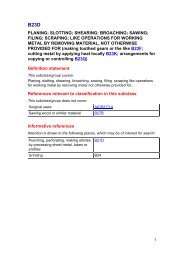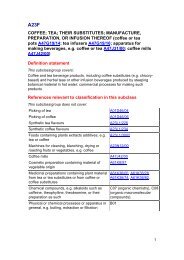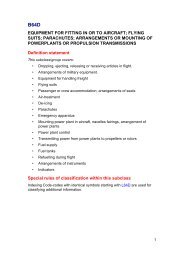A61K - Cooperative Patent Classification
A61K - Cooperative Patent Classification
A61K - Cooperative Patent Classification
You also want an ePaper? Increase the reach of your titles
YUMPU automatically turns print PDFs into web optimized ePapers that Google loves.
CPC - <strong>A61K</strong> - 2013.07 - page 53<br />
complexed to a modifying agent }<br />
NOTE<br />
-<br />
The modifying agent being a macromolecular compound <strong>A61K</strong> 47/48 K, a<br />
peptide, protein or polyamino acid <strong>A61K</strong> 47/48 R, an antibody or<br />
immunoglobulin <strong>A61K</strong> 47/48 T<br />
<strong>A61K</strong> 47/48015 . . . { the modifying agent being an inorganic compound; e.g. inorganic ion that<br />
being chemically complexed with the pharmacologically- or<br />
therapeutically-active agent ( <strong>A61K</strong> 47/48161 takes precedence ) }<br />
NOTE<br />
-<br />
Classic ion pairs of medicinal agents are not classified in <strong>A61K</strong> 47/48 but<br />
in <strong>A61K</strong> 31/00<br />
<strong>A61K</strong> 47/48023 . . . { the modifying agent being an organic compound ( <strong>A61K</strong> 47/48161 takes<br />
precedence ) }<br />
<strong>A61K</strong> 47/4803 . . . . { the modifying agent being an organic ion that forms an ion pair complex<br />
with the pharmacologically or therapeutically active agent. }<br />
<strong>A61K</strong> 47/48038 . . . . { the modifying agent being a carboxylic acid, e.g. a fatty acid or an amino<br />
acid }<br />
NOTE<br />
-<br />
When covalently linked to the pharmacologically or<br />
therapeutically-active agent, it can be via its carboxylic function or via<br />
another chemical function leaving the carboxylic function free<br />
<strong>A61K</strong> 47/48046 . . . . { the modifying agent being a lipid, e.g. a triglyceride; the modifying agent<br />
being a polyamine, e.g. spermine or spermidine }<br />
NOTE<br />
-<br />
Fatty acid conjugates are classified in <strong>A61K</strong> 47/48038 ;cholesterol<br />
conjugates are classified in <strong>A61K</strong> 47/48123<br />
<strong>A61K</strong> 47/48053 . . . . . { the modifying agent being a phospholipid. }<br />
<strong>A61K</strong> 47/48061 . . . . { the modifying agent being a heterocyclic compound ( <strong>A61K</strong> 47/48153 takes<br />
precedence ) }<br />
<strong>A61K</strong> 47/48069 . . . . . { the modifying agent being a heterocyclic compound which being a<br />
porphyrine or a porphyrine with an expanded ring system, e.g.<br />
texaphyrine }<br />
NOTE<br />
-<br />
Porphyrins used as photosensitizers in photodynamic therapy: see<br />
<strong>A61K</strong> 41/0071 or <strong>A61K</strong> 41/0076 ; Porphyrins used as<br />
photosensitizers in photodynamic therapy, the photosensitizer being<br />
considered as the therapeutically active part, and modified by<br />
another compound, e.g. polymer or an antibody, to be classified in<br />
<strong>A61K</strong> 41/0071 or <strong>A61K</strong> 41/0076 and according to the <strong>A61K</strong> 47/48<br />
subgroup of the modifying agent; Porphyrins used as fluorescent<br />
diagnostic optical agents administered in vivo to be classified in<br />
<strong>A61K</strong> 49/0036





